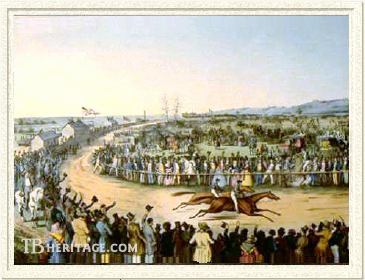|
|
Peytona

|
|
 |
|
|
Peytona was bred by James Jackson at Forks of Cypress, Alabama, and foaled in 1839, shortly before his death. She was, perhaps, the ultimate reflection of his breeding success, as she was by Glencoe, imported by Jackson and standing at Forks of Cypress, and out of Giantess, by Jackson's first significant import, Leviathan. Her second dam, a mare by Sir Archy, descended from that most significant of early imported mares, Selima (Family 21).
Peytona was a big mare at maturity, 16 hands and 3/4 inches tall, and a rich dark chestnut color, with a deep girth and powerful hocks, and a twenty seven foot stride. Initially called Glumdalclitch, after the giantess in Gulliver's Travels, her name was changed when she ran in and won the Peyton Stake at age 4, for which she was nominated, as yet unborn, in 1838. It was a four mile produce stake (the type of race now called a futurity) to be run at Nashville in the fall of 1843. The subscription fee for nomination was $5,000, and even though only thirty were nominated, and of those, some $1,000 forfeit fees were never paid, the race, when held, was the richest ever, in the world, with a value of $35,000. Four heats were run, and Peytona decisively won the last two, over the imported Herald and two others. Peytona went on to win a total of $62,400, a record in the U.S. for fifteen years.
Another historic race she won, in 1845, was her famous match against the aging great race mare, "Queen of the Turf," Fashion. "Her immense stride and strength, and her 'nice ideal of perpetual motion' did the business. It is a matter of doubt with some, whether Fashion ever saw the day when she could beat Peytona. Certainly Peytona not only outfooted her but outlasted her." This race, held over the Union course, for a purse of $10,000, was a national event, well-publicized and attended by at least 70,000. It was one of a series of North-South matches in the 1840s on which large wagers were placed on each region's favored representative, the first most celebrated one being a match between Boston and Fashion. In a rematch at Camden six weeks later, Fashion won handily in two heats, "without ever being put to speed," and Peytona came out of the race lame.
Peytona was obtained by Keene Richards for his Blue Grass stud after two years' layoff and a subsequent short return to the track in a race she was unable to finish, the result of hot feet and fetlocks after her match against Fashion. She was first bred to Ruby (1836, by Emilius), a stallion imported in utero by Thomas Kirkman of Alabama, a nephew of James Jackson, who was later executor of his estate. Ruby's dam, Eliza (1823), was by Rubens, a full brother to Selim, Glencoe's grandfather, making Peytona's two daughters by Ruby 4 x 5 to Buzzard and the Alexander mare.
Peytona produced two fillies by Ruby. Her chestnut filly of 1850 bred on, and is still seen in tail-female descent in racehorses today. Richards had other plans for this great race mare, however, and she was, from 1854 through 1859 bred to his imported arabian stallions in his serious, but ill-fated, attempt to re-introduce "pure" arabian bloodstock into racing. Of her offspring from those breedings, none successful on the turf, only her half-arabian daughter, Transylvania (1855), produced anything of note -- the in-bred Limestone, a son of War Dance, who won 19 races in 1874, including stakes races on the flat and over fences. In 1860 Richards bred Peytona to Knight of St. George, winner of the Irish St. Leger, who he had imported from Great Britain, producing a chestnut filly in 1861, and the following year she died foaling a colt by imported Mickey Free. She was buried at the Blue Grass Stud, next to her sire, Glencoe.
--Patricia Erigero
|
|
|
|

